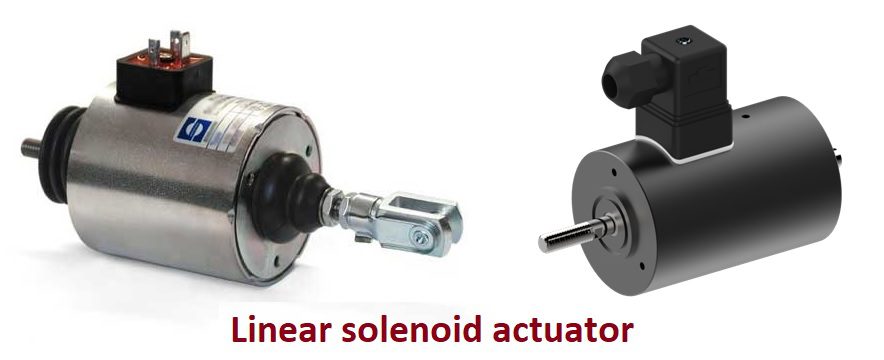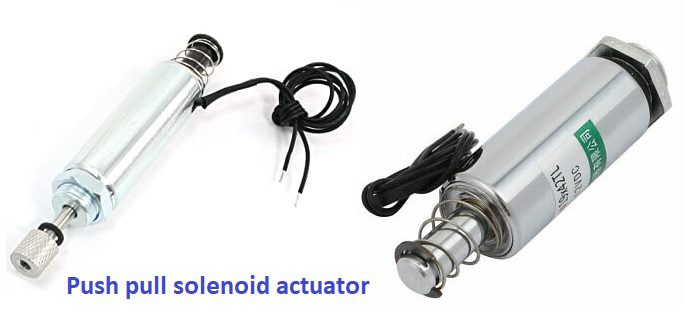Table of Contents
Introduction-
Solenoid actuator is electrically operated actuator that uses electric supply to deliver linear motion of actuator or plunger. It consists of an electric coil with a movable ferromagnetic core (plunger) in its centre. When electric voltage is applied to the coil, current passes through the coil which creates a magnetic field. The magnetic field forces the plunger to move upward and enables opening the orifice or closing of orifice depending on its valve configuration used. There can be used with various valve configurations as per requirement. A simple linear solenoid actuator diagram is shown below-
Structure-
These actuators are available in a variety of configurations but most commonly linear Solenoid actuator is used. It consists of an electric coil wounded in a cylindrical structure enclosed by a casing and in its centre, a movable ferromagnetic core (also referred as plunger) with spring loaded mechanism. Here spring mechanism is used to return plunger at rest position when no electrical supply. There are two arrangements possible – one is “pull type” in which plunger pull the connected load towards itself when energized. Another arrangement is “push type” which push the plunger and its connected load outside when energized. Basic construction of both arrangements is same but the main difference is in return spring position as well as design of the plunger. A typical structure is shown below-
Working principle-
Solenoid working is based on force acting on a ferromagnetic core due to magnetic field produced by a current carrying coil. When electric voltage is applied to the solenoid coil, current passes through the coil and it behaves like an electromagnet and creates a magnetic field. The magnetic field forces the plunger to move upward in opposite of spring mechanism and enables opening the orifice or closing of orifice depending on its valve configuration.
When solenoid coil is de-energised i.e. supply voltage removed, there will be no current passing through coil. Thus no magnetic field is generated and energy stored in the compressed spring revert back or forces the plunger back to get its rest position.
Linear solenoid actuator-
When a solenoid actuator delivers straight line motion of plunger, it is referred as linear solenoid actuator. Linear configuration is the mostly preferred over rotary solenoid actuator. Linear solenoids are used in various applications such as for on-off application of control valves, emergency shutdown valves. to electrically open doors and latches, to move and operate robotic limbs and mechanisms, to actuate electrical switches, etc. Rotary type configuration produces a rotational movement at some fix angle. Both types of solenoi actuators can be used as either a holding configuration (continuous signal to maintain coil energized) or as a latch configuration (pulse signal to energize at once).
Solenoid valve actuator-
A Solenoid valve actuator is such type of actuator that is used to operate i.e. to open or to close a valve by applying an electrical current to an electromagnetic coil. Here principle of operation is same like any solenoid actuator. When current passes through the solenoid coil, magnetic field produces that forces the plunger to move upward in opposite of spring mechanism hence causing a control rod or arm to move and enable to open valve. Here valves can be globe valve, needle valve, gate valve. It is used where valves are controlled from remote locations. It can be operated by manual switches in a control room, or by control systems connected to control process in plants. They can be used in pneumatic or hydraulic circuits too. A diagram of solenoid valve actuator is shown below-
Push pull solenoid actuator-
Push pull solenoid actuator is basically on/off type actuator that develops force in one direction when energized and return to rest is provided by external force using spring return mechanism like other linear solenoids. They are ideal actuators for applications where power consumption and heat dissipation are critical. In such actuator, push and pull both action is available because it has two shaft end (of plunger) that can be used to connect load, thus solenoid can be used for either pushing or pulling load depending on which end is connected to mechanical load. A diagram of Push pull solenoid actuator is shown in figure-
Click on the below links to read more about-
- Solenoid Operated Valve (SOV)
- Difference between single acting and double acting cylinder
- What is an actuator?
- What is control valve?
- Electric actuator
- What are different types of actuator?
- Sensor Vs Actuator
- Piston (Wikipedia link)
- सोलेनॉइड एक्ट्यूएटर | Solenoid actuator in hindi
- Differential Pressure Gauge




